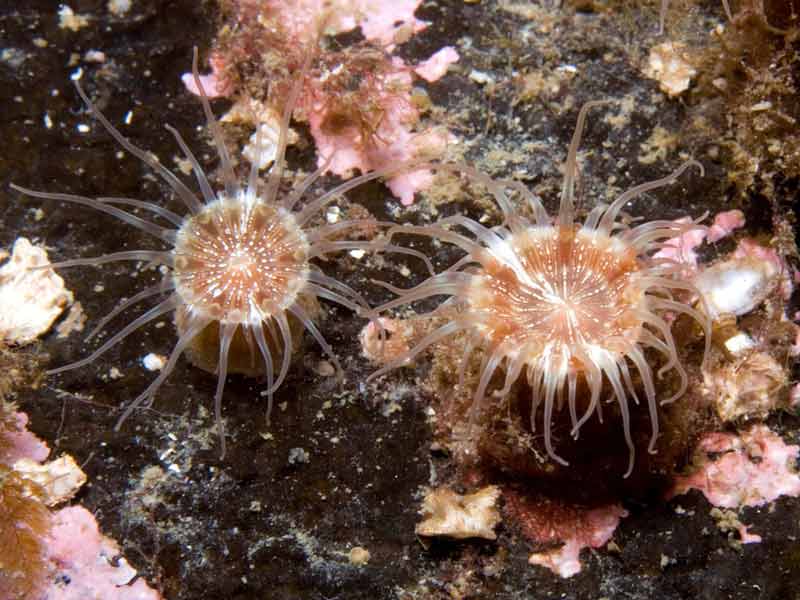A sea anemone (Hormathia coronata)
Distribution data supplied by the Ocean Biodiversity Information System (OBIS). To interrogate UK data visit the NBN Atlas.Map Help
| Researched by | Frances Peckett & Dr Samantha Garrard | Refereed by | Admin |
| Authority | (Gosse, 1858) | ||
| Other common names | - | Synonyms | - |
Summary
Description
Recorded distribution in Britain and Ireland
Recorded from the English Channel, western and northern coasts of Ireland, western Scotland and the Shetland Isles.Global distribution
Recorded from the Mediterranean, around south western Europe to northern France.Habitat
Occurs usually attached to organic substrata, such as shells and worm tubes but can also be found attached to stones or rocks. A sublittoral species which occurs down to 100 m.Depth range
-Identifying features
- The disc and tentacles are orange and light brown with the tentacles moderate in length and arranged in multiples of 6.
- The major part of the column, directly above the base, is orange, red, brown or buff with the column above being dark brown often purplish and with a white line encircling the upper most limit.
Additional information
Plastic sheeting found in the sea off Dawlish, Devon, is reported by fishermen to be the only known habitat in that area for Hormathia coronata.Listed by
- none -
Bibliography
BMLSS (British Marine Life Study Society), 2002b. Ethics and conservation on the shore, [On-line] http://ourworld.compuserve.com/homepages/BMLSS/ethics.htm, 2002-07-17
Howson, C.M. & Picton, B.E., 1997. The species directory of the marine fauna and flora of the British Isles and surrounding seas. Belfast: Ulster Museum. [Ulster Museum publication, no. 276.]
JNCC (Joint Nature Conservation Committee), 1999. Marine Environment Resource Mapping And Information Database (MERMAID): Marine Nature Conservation Review Survey Database. [on-line] http://www.jncc.gov.uk/mermaid
Manuel, R.L., 1988. British Anthozoa. Synopses of the British Fauna (New Series) (ed. D.M. Kermack & R.S.K. Barnes). The Linnean Society of London [Synopses of the British Fauna No. 18.]. DOI https://doi.org/10.1002/iroh.19810660505
Picton, B.E. & Costello, M.J., 1998. BioMar biotope viewer: a guide to marine habitats, fauna and flora of Britain and Ireland. [CD-ROM] Environmental Sciences Unit, Trinity College, Dublin.
Datasets
Centre for Environmental Data and Recording, 2018. Ulster Museum Marine Surveys of Northern Ireland Coastal Waters. Occurrence dataset https://www.nmni.com/CEDaR/CEDaR-Centre-for-Environmental-Data-and-Recording.aspx accessed via NBNAtlas.org on 2018-09-25.
Manx Biological Recording Partnership, 2022. Isle of Man historical wildlife records 1990 to 1994. Occurrence dataset:https://doi.org/10.15468/aru16v accessed via GBIF.org on 2024-09-27.
NBN (National Biodiversity Network) Atlas. Available from: https://www.nbnatlas.org.
OBIS (Ocean Biodiversity Information System), 2025. Global map of species distribution using gridded data. Available from: Ocean Biogeographic Information System. www.iobis.org. Accessed: 2025-07-24
Citation
This review can be cited as:
Last Updated: 23/06/2008



